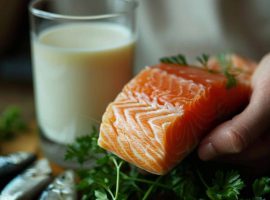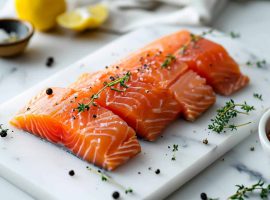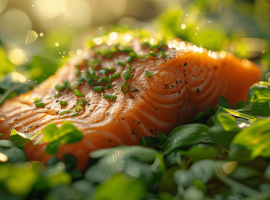Omega-3 Fatty Acids: Vital for Cancer Prevention
Omega-3 fatty acids are essential fats that play a crucial role in the body’s cellular functions. They are primarily found in fish and are known for their anti-inflammatory properties and potential to reduce the risk of chronic diseases, including cancer. The body cannot produce these fatty acids, making it necessary to obtain them through diet.
The Impact of EPA and DHA on Cancer Risk
Eicosapentaenoic acid (EPA) and docosahexaenoic acid (DHA) are long-chain omega-3 fatty acids that contribute significantly to the structural integrity of cell membranes. Research suggests that EPA and DHA may help prevent cancer by inhibiting abnormal cell growth and inducing apoptosis in cancerous cells.
Scientific Evidence Linking Omega-3 Intake to Cancer Prevention
A growing body of scientific evidence indicates that higher intake of omega-3 fatty acids is associated with a reduced risk of certain cancers, particularly those of the breast and prostate. Studies have shown that omega-3s can interfere with the growth of cancer cells and may enhance the efficacy of chemotherapy drugs.
Dietary Choices and Omega-3 Production
Since the human body cannot synthesise omega-3 fatty acids, incorporating fish rich in EPA and DHA, such as salmon, mackerel, and sardines, into one’s diet is essential. Regular consumption of these fish can help maintain adequate levels of omega-3s, which are vital for overall health and may aid in cancer prevention.
Identifying Fish with High Omega-3 Content
Omega-3 fatty acids, particularly EPA and DHA, are pivotal in the prevention of various cancers. Certain fish species are rich in these essential nutrients. Salmon, mackerel, and sardines stand out for their substantial omega-3 content. Regular inclusion of these fish in your diet can contribute to a cancer-preventive nutritional regimen.
Comparing Omega-3 Levels in Fish
When comparing omega-3 levels, salmon is renowned for its high content, particularly of DHA, which is crucial for brain health. Mackerel, not far behind, is another excellent source of EPA and DHA. Sardines, often overlooked, are not only abundant in omega-3s but also offer the added benefit of being lower on the food chain, thus containing lesser contaminants like mercury.
Benefits of Omega-3-Rich Fish in Cancer Prevention
Incorporating these fish into your diet can aid in reducing inflammation and potentially lowering the risk of cancer development. The anti-inflammatory properties of omega-3 fatty acids are essential in combating oxidative stress, which is linked to cancer.
Selecting Optimal Omega-3 Sources
To ensure optimal omega-3 intake, consumers should seek out fresh, wild-caught, or responsibly farmed options where possible. Labels and certifications can guide you to sustainably sourced fish, which often have a superior omega-3 profile. Additionally, a variety of fish in your diet can minimise exposure to any single type of contaminant, balancing benefits and risks effectively.
Frequency and Serving Sizes: Optimal Fish Consumption for Cancer Prevention

Current Recommendations for Fish Intake
Health authorities commonly recommend consuming at least two servings of fish per week to harness its cancer-preventive benefits. This frequency is linked to a reduced risk of several chronic diseases, including certain types of cancer.
Health Benefits of Regular Fish Consumption
Consuming fish twice weekly is associated with improved heart and brain health, owing to the high levels of omega-3 fatty acids. These essential nutrients are crucial for maintaining cellular integrity and reducing inflammatory processes that can lead to cancer.
Serving Size Variations Among Fish Types
Different fish species have varying levels of nutrients; hence, serving sizes may differ. Fatty fish like salmon and mackerel are often recommended in smaller portions compared to leaner fish due to their high energy content.
Dietary Considerations for Individual Needs
For individuals with specific dietary requirements, such as pregnant women or those with certain health conditions, tailored advice on fish consumption is essential. It is crucial to consider factors like mercury content, especially in high-mercury fish, to ensure safe consumption levels.
Balancing Benefits and Risks: Mercury and Other Contaminants

Assessing the Health Benefits Versus Contaminant Risks
The health benefits of fish consumption, particularly due to omega-3 fatty acids, are substantial, including reduced risks of heart disease and certain cancers. However, these benefits must be weighed against the potential risks from contaminants like mercury. Understanding this balance is crucial for safe fish consumption.
High-Mercury Fish to Limit or Avoid
Fish known to have higher levels of mercury include shark, swordfish, king mackerel, and tilefish. You’re advised to consume these fish sparingly, if at all, to minimise mercury exposure, which can be particularly harmful to the nervous system.
Minimising Contaminant Risks
To reduce the risks associated with fish contaminants, diversify your seafood intake, and opt for species with lower mercury levels, such as salmon, sardines, and trout. Additionally, checking local advisories for specific water bodies can guide you in selecting safer options.
Guidelines for Vulnerable Groups
Vulnerable groups, such as pregnant women, breastfeeding mothers, and young children, should adhere to specific guidelines to limit mercury exposure. These include avoiding high-mercury fish and consuming a variety of seafood that’s lower in mercury, following the recommendations provided by health authorities.
The Role of Fish in Specific Cancer Types Prevention

Cancer Types Potentially Affected by Fish Consumption
Regular fish consumption has been associated with a lower risk of several types of cancer, notably those of the breast and digestive tract. The inclusion of fish rich in omega-3 fatty acids in one’s diet is considered a proactive measure in cancer prevention strategies.
Omega-3 Fatty Acids and Cancer Risk Reduction
Omega-3 fatty acids, particularly EPA and DHA found in fish, are believed to play a role in cancer prevention through several mechanisms:
– Anti-inflammatory properties: Chronic inflammation is a known risk factor for cancer; omega-3s can mitigate this.
– Cellular health maintenance: These fatty acids help maintain cell membrane integrity, reducing the risk of malignant transformations.
– Inhibition of tumour growth: Omega-3s have been shown to inhibit the growth of cancerous cells in some studies.
Dietary Patterns and Regional Cancer Risk
Dietary patterns, including fish consumption, can influence regional cancer risk variations. For instance, populations adhering to diets with higher fish intake, such as in certain Asian countries, have shown different cancer prevalence rates compared to Western populations, where red meat consumption is more common. This suggests that diet, including fish consumption, may play a significant role in cancer epidemiology.
Sustainable Choices: Wild-Caught and Responsibly Farmed Fish

Importance of Sustainable Fish Selection
Choosing wild-caught or responsibly farmed fish is crucial for both environmental sustainability and personal health. Sustainable fishing practices ensure the long-term viability of marine ecosystems and provide you with nutrient-rich options that are less likely to be contaminated with pollutants.
Nutritional Quality and Sustainable Sourcing
Sustainability practices often lead to superior nutritional quality in fish. Wild-caught fish, for instance, tend to have a more varied diet and cleaner environment, which can result in higher levels of omega-3 fatty acids. Responsibly farmed fish are raised with stringent standards to minimise pollutants and maintain a natural diet.
Certifications for Sustainable Seafood
When selecting fish, look for certifications such as the Marine Stewardship Council (MSC) or Aquaculture Stewardship Council (ASC) labels. These indicate that the seafood has met rigorous environmental and sustainability standards.
Frozen Fish Direct’s Commitment to Sustainability
Frozen Fish Direct ensures the sustainability of their products by sourcing from fisheries and farms that adhere to strict environmental and quality guidelines. They prioritise suppliers who demonstrate a commitment to maintaining healthy fish populations and ecosystems, ensuring that your seafood choices support both the planet and your health.
Preparing Fish for Maximum Health Benefits

Healthiest Cooking Methods for Cancer-Preventive Properties
To preserve the cancer-preventive properties of fish, particularly the omega-3 fatty acids, certain cooking methods are recommended:
- Grilling: Quick and high-heat grilling can retain omega-3 content while imparting a smoky flavour.
- Baking: This gentle cooking method preserves the integrity of omega-3s and minimises the formation of harmful compounds.
- Broiling: Similar to grilling, broiling offers a quick cooking process that can help maintain the nutritional profile of fish.
Differences in Cooking Methods
Each cooking method impacts the health benefits of fish differently:
- Grilling and Broiling: These methods can reduce added fats and are suitable for fatty fish, which already contain natural oils.
- Baking: Ideal for leaner fish, baking can prevent the drying out of the flesh and does not require additional fats.
Tips for Safe Cooking
To ensure safety and prevent contamination:
- Parasite Prevention: Cooking fish to an internal temperature of 145F (63C) is crucial.
- Bacteria Mitigation: Proper handling and storage, including thorough cleaning of surfaces and utensils, are essential.
Maximising Health Benefits with Frozen Fish Direct
Frozen Fish Direct’s offerings can be prepared using these methods to maximise health benefits. Their products, frozen at peak freshness, ensure nutrient retention and provide a convenient option for incorporating high-quality fish into your diet.
Alternative Omega-3 Sources for Individuals Not Consuming Fish

For those who do not consume fish, a variety of plant-based options are available to ensure adequate omega-3 intake:
- Flaxseeds and flaxseed oil
- Chia seeds
- Walnuts
- Canola oil
- Soybeans and soy products
These plant sources primarily provide alpha-linolenic acid (ALA), which the body can convert to EPA and DHA, albeit at a low conversion rate.
Comparing Fish Oil Supplements and Whole Fish
Fish oil supplements are a concentrated source of omega-3s and can be beneficial for individuals not consuming fish. However, they may offer fewer additional nutrients, such as protein and certain vitamins, compared to whole fish.
Challenges in Omega-3 Absorption from Non-Fish Sources
The main challenge in obtaining omega-3 from non-fish sources is the lower bioavailability and conversion rate of ALA to EPA and DHA. This means you may need to consume larger amounts of plant-based omega-3s to achieve the same health benefits as those from fish.
Frozen Fish Direct’s Offerings for Omega-3 Alternatives
Frozen Fish Direct caters to customers seeking alternative omega-3 sources by providing a selection of fish oil supplements and frozen options that are rich in omega-3s, ensuring that even non-fish eaters have access to these essential nutrients.
Nutritional Profiles: Beyond Omega-3s

Fish is a nutritional powerhouse, offering more than just omega-3 fatty acids. It provides a host of other nutrients that play a role in cancer prevention and overall health.
Essential Nutrients in Fish for Health Support
Fish is rich in high-quality protein, which is essential for repairing body tissues and maintaining a healthy immune system. Vitamins D and B2 (riboflavin), found in fish, are crucial for bone health and energy metabolism, respectively. The minerals present in fish, such as zinc and magnesium, support various bodily functions, including nerve function and cellular metabolism.
The Role of Iodine and Selenium
Iodine is vital for thyroid health, while selenium acts as an antioxidant, helping to protect cells from damage. Both minerals are abundant in fish and contribute to its cancer-preventive properties.
Diverse Nutrient Range in Frozen Fish Direct’s Selection
Frozen Fish Direct offers a variety of fish, each with a unique nutritional profile. This variety ensures that you can obtain a broad spectrum of nutrients to support overall health and potentially reduce the risk of cancer. Their selection includes:
- Salmon: High in vitamin D and selenium
- Mackerel: Rich in omega-3s and vitamin B12
- Cod: Good source of iodine and protein
- Trout: Contains B vitamins and phosphorus
By incorporating different types of fish into your diet, you can benefit from the wide range of nutrients they offer.
Cultural Significance of Fish in Native American Diets

Salmon’s Role in Native American Culture
For Native American Indian Tribes, fish, particularly salmon, hold profound cultural and spiritual significance. Salmon are not only a dietary staple but also a symbol of life, sustenance, and renewal. Their annual migration is celebrated and deeply respected within these communities.
Influence of Cultural Practices on Fish Consumption
Cultural traditions dictate the types of fish consumed and their preparation methods. Smoking and drying are common practices, preserving fish for off-season use and honouring age-old techniques. These methods also impart unique flavours and textures, making fish an integral part of cultural cuisine.
Health Outcomes from Traditional Fish Consumption
The traditional fish-centric diet of many Native American tribes has been associated with positive health outcomes. The high intake of omega-3 fatty acids from fish like salmon correlates with lower incidences of heart disease and supports cognitive health among these populations.
Frozen Fish Direct’s Cultural Accommodations
Frozen Fish Direct recognises the diverse cultural preferences of their customers, offering a variety of fish that cater to different cultural practices and dietary restrictions. They ensure that options like wild-caught salmon, which is significant to Native American diets, are readily available, supporting not only health but also cultural heritage.
Government and Organisational Guidelines on Fish Intake

U.S. Government and Health Organisations’ Recommendations
U.S. government websites and health organisations advocate for the inclusion of fish in your diet, emphasising the importance of omega-3 fatty acids for overall health and potential cancer prevention. The general guideline suggests consuming at least two servings of fish per week, with a focus on varieties rich in omega-3s and low in mercury.
Alignment with Cancer Prevention Research
These dietary recommendations are supported by research linking the intake of omega-3 fatty acids from fish with a reduced risk of certain cancers. Organisations like the American Institute for Cancer Research (AICR) underscore the role of diet, including fish consumption, in cancer prevention strategies.
Philanthropic Support for Cancer Research and Dietary Education
Philanthropic efforts play a vital role in funding cancer research and dietary education initiatives. Donations and fundraising events contribute to the ongoing study of the relationship between diet and cancer, helping to refine dietary guidelines and inform the public.
Frozen Fish Direct’s Commitment to Health Education
Frozen Fish Direct aligns with these guidelines by providing a selection of omega-3-rich fish, ensuring that customers have access to seafood that supports their health goals. They also engage in educational efforts to inform customers about the benefits of fish consumption and how to choose and prepare fish to maximise health benefits.
Integrating Fish into a Holistic Cancer-Preventive Diet

Incorporating fish into a diet aimed at cancer prevention involves more than just selecting the right types of fish. It’s about creating a balanced dietary pattern that supports overall health and complements other lifestyle choices conducive to reducing cancer risk.
Practical Steps for Including Fish in Your Diet
To seamlessly integrate fish into your regular diet, consider the following steps:
- Plan Weekly Meals: Include fish in at least two meals per week, focusing on varieties rich in omega-3 fatty acids like salmon, mackerel, and sardines.
- Explore Recipes: Experiment with healthy cooking methods such as grilling, baking, or broiling to prepare fish dishes that retain their nutritional value.
- Diversify Your Intake: Rotate between different types of fish to enjoy a range of nutrients and minimise exposure to any single type of contaminant.
Staying Informed on Fish and Cancer Prevention
To stay abreast of the latest research on fish consumption and cancer prevention:
- Follow Reputable Sources: Regularly check updates from authoritative health organisations and peer-reviewed journals.
- Attend Health Workshops: Participate in workshops or seminars that focus on nutrition and cancer prevention.
Frozen Fish Direct’s Role in Informed Seafood Choices
Frozen Fish Direct aids customers in making informed choices by:
- Providing Detailed Product Information: Offering insights into the nutritional content and source of their seafood.
- Ensuring Quality and Sustainability: Selecting products from sustainable sources that adhere to environmental and health standards.









